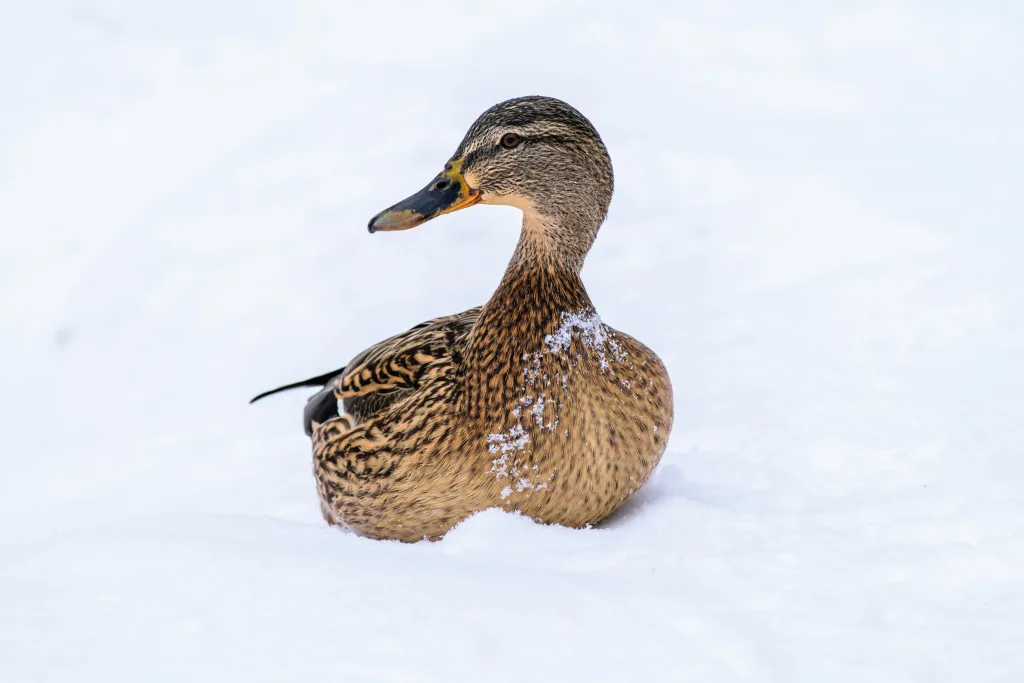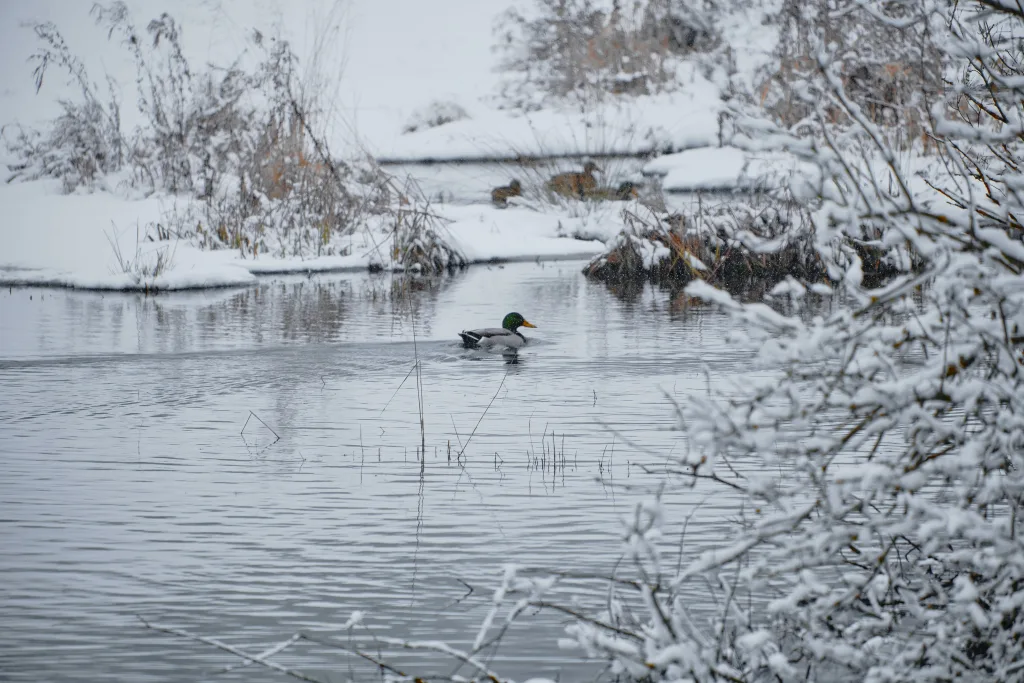Ducks, like many waterfowl, possess remarkable adaptations that allow them to survive in cold weather. One of their key adaptations is their dense layers of insulating feathers, which help to keep them warm even in freezing temperatures. These feathers trap air close to their bodies, creating a layer of insulation that helps to retain their body heat.
In addition to their feathers, ducks also have a unique adaptation known as counter-current blood flow. This adaptation helps to reduce heat loss through their feet and legs, which are exposed to cold water. By having warm arterial blood flowing close to the cold venous blood returning to the body, ducks are able to minimize heat loss and keep their extremities warm.
Furthermore, ducks exhibit behavioral modifications to reduce exposure to the harsh winter elements. They often seek sheltered areas such as coves, marshes, or dense vegetation, where they can find protection from strong winds and extreme cold. Ducks also have the ability to roost (sleep) on the ground or float on water, depending on the species. For example, mallards are known to sleep both on land and water, while Muscovy ducks can roost on the ground.
When it comes to food availability, ducks either migrate south or change their local movement patterns in response to declining open water and food sources. As snow covers the ground, it buries or makes food less accessible to ducks. Additionally, ice cover significantly reduces the available habitat for ducks and can limit their movement. This can also impact duck hunters, as they may have difficulty accessing hunting grounds.
While ducks are generally well-adapted to cold temperatures, they can suffer from frostbite if exposed to extreme cold for prolonged periods. Frostbite is particularly a risk for their feet, which could lead to amputation if not addressed. To mitigate this, it is important to provide ducks with suitable shelter and bedding. Straw, wooden planks, benches, or low stumps in their pen can help them keep their feet off the frozen ground and maintain warmth.
Ducks have evolved a range of adaptations to survive in cold weather. Their insulating feathers, counter-current blood flow, behavioral modifications, and ability to carry fat reserves all contribute to their ability to endure freezing temperatures. Whether they migrate or adapt their movement patterns, ducks seek sheltered areas and find ways to access food sources even in harsh winter conditions. By understanding and respecting their needs, we can help ensure the well-being of these resilient waterfowl during the winter months.
How Do Wild Ducks Survive Winter?
Wild ducks survive winter through a variety of remarkable adaptations that allow them to withstand the harsh conditions. These adaptations include:
1. Insulating Feathers: Ducks have dense layers of feathers that provide excellent insulation against the cold. These feathers trap air close to the body, creating a layer of warm air that helps to maintain their body temperature.
2. Counter-current Blood Flow: Ducks have a unique circulatory system that minimizes heat loss through their feet and legs. The arteries and veins in their legs are arranged in close proximity, allowing warm arterial blood to transfer heat to the cooler venous blood before returning to the body. This prevents excessive heat loss through their extremities.
3. Behavioral Modifications: Ducks adapt their behavior to reduce exposure to the elements. They seek shelter in protected areas such as reed beds, marshes, or dense vegetation, which provide a buffer against wind and cold temperatures. They may also huddle together in groups to conserve body heat.
4. Large Fat Reserves: Ducks have the ability to store large reserves of fat before winter. This fat acts as an energy source during periods of low food availability, helping them to maintain their body temperature and survive through the winter months when food may be scarce.
5. Migration: Many wild ducks are migratory, undertaking long-distance journeys to find more favorable wintering grounds. They fly to areas with milder climates and abundant food resources. By migrating, ducks can avoid the harsh winters in their breeding grounds and ensure their survival.
6. Feeding Adaptations: Ducks adapt their feeding behavior during winter. They forage in shallow water or on land, where they can easily access food sources such as aquatic plants, seeds, insects, and small aquatic animals. Some ducks also have specialized bills that help them filter and sift food from the water.
The survival of wild ducks during winter is attributed to their ability to insulate themselves with feathers, regulate heat loss through counter-current blood flow, modify their behavior, store fat reserves, migrate to more favorable habitats, and adapt their feeding strategies. These adaptations allow them to endure the cold and challenging conditions of winter successfully.

Where Do Ducks Sleep In The Winter?
Ducks have various sleeping habits, and their choice of sleeping location can vary depending on the season, including winter. During the winter months, ducks often search for sheltered areas to protect themselves from the cold weather and potential predators. Here are some common places where ducks may sleep during the winter:
1. Ice-free bodies of water: Ducks prefer to sleep on open water to avoid freezing temperatures. They can sleep while floating on the water, using their buoyant bodies to stay afloat. This allows them to conserve body heat and stay safe from land predators.
2. Wetlands and marshes: Ducks may seek out wetlands or marshes that remain unfrozen during the winter. These areas provide a natural habitat with ample food sources and protection. Ducks can sleep on the water’s surface or in the vegetation surrounding the wetlands.
3. Sheltered coves or inlets: Ducks may choose to sleep in sheltered areas, such as coves or inlets along the water’s edge. These areas provide some protection from strong winds and freezing temperatures, allowing ducks to find refuge while sleeping.
4. Open fields or meadows: Some species of ducks, like mallards, may sleep on land during the winter. They may choose open fields or meadows where they can rest and conserve energy. These areas should be relatively safe from predators and provide easy access to food sources.
5. Tree branches or roosting boxes: Certain species of ducks, such as wood ducks, may sleep in trees or roosting boxes during the winter. These ducks have strong claws that enable them to perch on branches, keeping them above the ground and away from predators.
It is important to note that the specific sleeping locations of ducks during the winter can vary depending on factors like their species, habitat availability, and local weather conditions. Ducks are adaptable and will choose the safest and most comfortable area to sleep, whether it’s on water, land, or in trees.
Do Ducks Migrate In Winter?
Ducks do migrate in winter. In response to declining open water and food availability, ducks have the ability to migrate to areas where these resources are more abundant. This is a natural instinct that helps them survive during the colder months.
During winter, snow can bury or make food less available for ducks. Additionally, ice cover significantly reduces the habitat available to ducks, making it difficult for them to find sufficient food and suitable living conditions. As a result, many ducks choose to migrate to regions where they can find open water and ample food sources.
Migration patterns vary among different duck species. Some ducks migrate long distances, traveling from their breeding grounds in the north to warmer regions in the south for the winter. These long-distance migrants often cover thousands of miles during their journey.
Other ducks, known as short-distance migrants, may not travel as far but still change their local movement patterns to find suitable habitats and food sources. These ducks may move to nearby areas with open water or seek out areas where the ice cover is less severe.
The decision to migrate or change movement patterns in winter is driven by the need for ducks to find adequate food and suitable habitats. By doing so, they can survive the harsh conditions and ensure their continued survival.
How Cold Is Too Cold For Ducks?
Ducks can tolerate temperatures as low as 20 degrees Fahrenheit without any major issues. However, when the temperature drops below this threshold, ducks can be at risk of suffering from frostbite on their feet. Frostbite occurs when the tissues freeze, leading to damage and potential loss of the affected body parts.
To prevent frostbite in ducks, it is important to provide them with suitable shelter and accommodations. Along with straw bedding, you can also make use of various other materials such as wooden planks, benches, or low stumps in their pen. These elevated surfaces allow the ducks to get off the frozen ground and keep their feet warmer.
Ducks can handle fairly cold temperatures, but once it goes below 20 degrees Fahrenheit, their feet become susceptible to frostbite. Providing appropriate insulation and surfaces for them to rest on can help prevent this issue.

Conclusion
Ducks are remarkable creatures that have evolved various adaptations to survive in cold weather. Their dense layers of insulating feathers, counter-current blood flow, and behavioral modifications help them reduce heat loss and exposure to the elements. Additionally, their ability to carry large fat reserves provides them with the necessary energy to endure harsh conditions. Ducks display flexibility in their choice of sleeping locations, with some species able to sleep both on land and water, while others roost on the ground. However, they may need assistance in extreme cold temperatures to prevent frostbite on their feet. Providing them with straw, wooden planks, benches, or low stumps in their pen can help keep their feet warm and protect them from the frozen ground. ducks are resilient and adaptable creatures that can thrive in various habitats, but their survival is dependent on access to open water and food availability.
